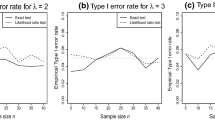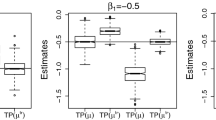Abstract
This paper proposes two sequential procedures for selecting respectively the multinomial cell with the largest cell probability and the multinomial cell with the smallest cell probability. The stopping rule for both procedures uses truncation of the procedure studied by Ramey and Alam (1979, Biometrika, 66, 171–173). A property of the least favorable configuration of the proposed procedures is proved, which partially solves a conjecture given in Ramey and Alam (1979). The proposed procedures are compared with other procedures which have been considered in the literature and are found to be better in certain respects.
Similar content being viewed by others
References
Alam, K. (1971). On selecting the most probable categogy, Technometrics, 13, 843–850.
Alam, K. and Thompson, J. R. (1972). On selecting the least probable multinomial event, Ann. Math. Statist., 43, 1981–1990.
Bechhofer, R. E. and Goldsman, D. M. (1985a). On the Ramey-Alam sequential procedure for selecting the multinomial event which has the largest probability, Commun. Statist. Simulation Comput., 14(2), 263–282.
Bechhofer, R. E. and Goldsman, D. M. (1985b). Truncation of the Bechhofer-Kiefer-Sobel sequential procedure for selecting the multinomial event which has the largest probability, Commun. Statist. Simulation Comput., 14(2), 283–315.
Bechhofer, R. E. and Goldsman, D. M. (1986). Truncation of the Bechhofer-Kiefer-Sobel sequential procedure for selecting the multinomial event which has the largest probability (II): extended talks and an improved procedure, Commun. Statist. Simulation Comput., 15(3), 829–851.
Bechhofer, R. E. and Kulkarni, R. V. (1984). Closed sequential procedures for selecting the multinomial events which have the largest probabilities, Commun. Statist. Theory Methods, 13(24), 2997–3031.
Bechhofer, R. E., Elmaghraby, S. and Morse, N. (1959). A simple-sample multiple-decision procedure for selecting the multinomial event which has the highest probability, Ann. Math. Statist., 30, 102–119.
Bechhofer, R. E., Kiefer, J. and Sobel, M. (1968). Sequential Identification and Ranking Procedure, The University of Chicago Press, Chicago.
Cacoullos, T. and Sobel, M. (1966). An inverse sampling procedure for selecting the most probable event in a multinomial distribution, Proceedings of International Symposium on Multivariate Analysis (ed. P. R. Krishnaiah), 423–455, Academic Press, New York.
Kesten, H. and Morse, N. (1959). A property of the multinomial population, Ann. Math. Statist., 30, 120–127.
Marshall, A. W. and Olkin, I. (1979). Inequalities: Theory of Majorization and Its Application, Academic Press, New York.
Ramey, J. T. and Alam, K. (1979). A sequential procedure for selecting the most probable multinomial event. Biometrika, 66, 171–173.
Author information
Authors and Affiliations
About this article
Cite this article
Chen, P. Truncated selection procedures for the most probable event and the least probable event. Ann Inst Stat Math 44, 613–622 (1992). https://doi.org/10.1007/BF00053393
Received:
Revised:
Issue Date:
DOI: https://doi.org/10.1007/BF00053393




